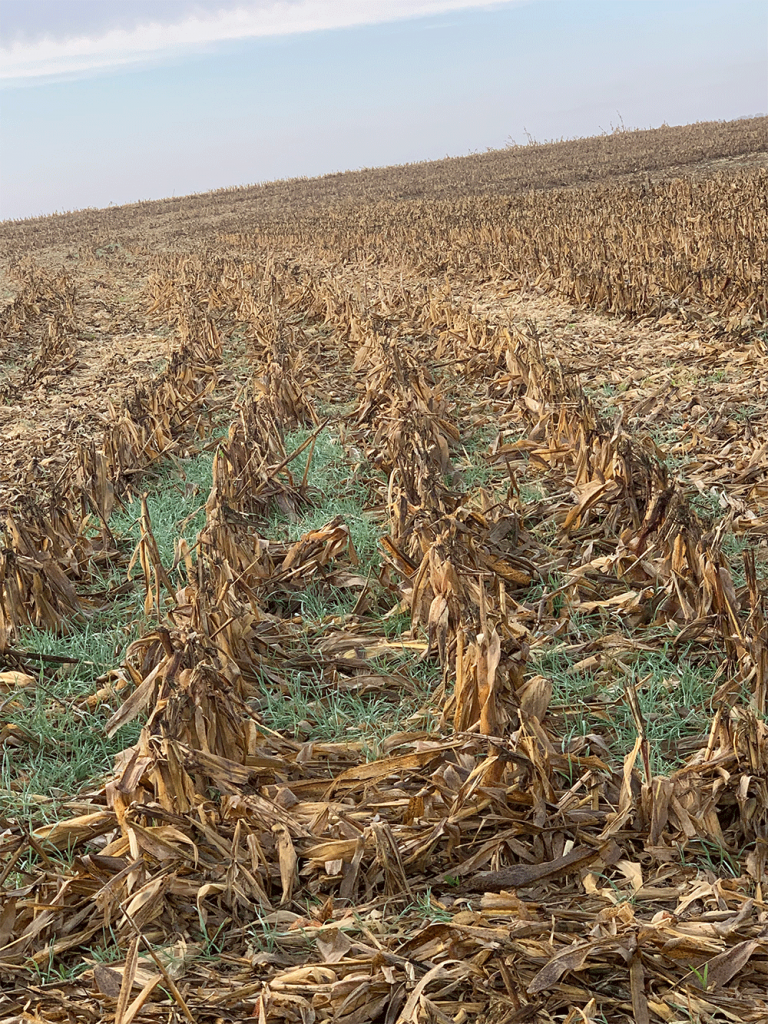
Julius Schaaf, a fifth-generation farmer in Fremont County, was impressed by how well the 2021 corn and soybean crops performed given exceptional dryness early in the growing season that had him wondering if he’d be able to fill grain contracts. Rains were still 6 to 9 inches behind the norm, but they came at the right times.
“I’ve farmed for 42 years. I have never raised soybeans this consistently good,” Schaaf said, adding that soybeans like to be a little bit dry early in the season. He has been 100% no-till on his rolling farmland for more than 25 years and plants cover crops on all corn ground going into beans.
This spring, he didn’t get his rye burned down as soon as he hoped and worried it would compete with soybeans for what moisture was available. “Our soybeans did every bit as good as anybody else, and we still had that protective cover until mid-April. There’s no drawback to cover crops that I can see with the competition for moisture.” And the benefit of a cover crop for holding the soil and building organic matter goes without question, he said.
His corn crop also impressed, with yields to date topping his actual production history by at least 20 bushels an acre.
Schaaf farms with his son, who is a believer in applying fungicides and used some dry fertilizer in June. Schaaf initially questioned that decision, but it turned out to be the right thing to do, with rains falling soon after.
Cover crops off to a great start

Schaaf reports his cover crops are doing well. They were flown onto cornstalks that will be going into beans next year during the last week of August, and beneficial rains followed.
The late-October rains also drove home the benefit of soil health practices for Schaaf. He commented that even after 5 inches of rain, there was no standing water in terraces. The ground has also been easier to farm after heavy rains since it can infiltrate the soil vs. standing on the surface and mucking up harvest or planting.
4R Plus practices put to use in rented-land discussions
Farmland is in short-supply, demand is high, and farm income is strong. Cash rental rates for Iowa farmland climbed an average of 4.5% in 2021, the first substantial increase since 2013, according to Iowa State University Extension and Outreach. Schaaf said producers can put good soil health practices to work when it comes to cash rent discussions.
“I think one thing a tenant can do to improve their stature with the landlords is to talk about the practices they would implement to preserve the soil and build organic matter,” Schaaf said. It’s not always about the highest dollar to landlords, he observed. “There are a lot of people interested in our sustainability and our ability to maintain farms in a high productive state,” Schaaf said. “But it doesn’t just happen by accident; it happens by design.”
Schaaf also advocates for the use of a flexible cash rent lease for “keeping everybody on an even keel.” Such agreements are similar to a crop share lease, but the landlord also receives a guaranteed minimum amount. The landlord then benefits from conservation and 4R stewardship practices.
Flexibility is also key heading into the next growing season
Looking ahead to the 2022 growing season, Schaaf is testing soybean ground going to corn using 2.5-acre grids and applying dry or anhydrous fertilizer only as the farm calls for it. “As expensive as it is, this is the time to make sure you’re utilizing it where you absolutely need it,” he said.
Schaaf’s operation is also watching some problems areas where erosion is an issue and adding terraces or grass waterways to keep the soil from washing away.
“At the end of the day, our goal is to utilize the 4R Plus practices that maintain the farm for future generations,” he said.
Click here to ask Julius Schaaf a question about the farming operation.
